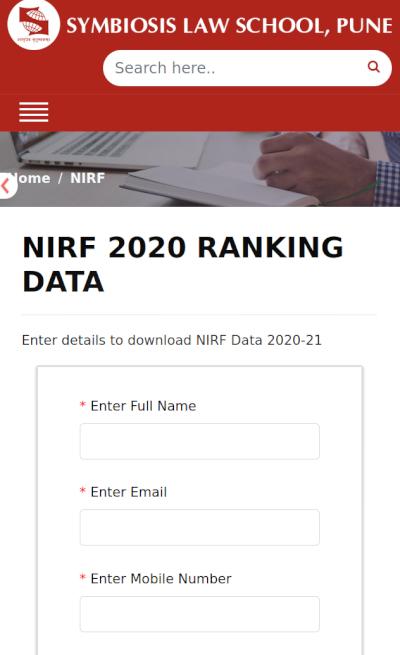The National Institutional Ranking Framework (NIRF) data and law school rankings are a treasure trove of information and over the next few weeks, we intend to dig deeper into the numbers to help law school aspirants from making more informed choices.
Particularly this year, with 97 law schools submitting information, those interested in law schools have a wider dataset than ever by which to make decisions.
The methodology of the NIRF involves some complicated maths but it is fairly transparent, with formulae published on its website in some detail.
However, it’s not necessarily easy to understand exactly why an institution is well-ranked in one category or another and there are always suspicions that it’s possible to massage some figures (particularly the median salary metrics can be subjective, hard to understand, and sometimes even downright false).
Nevertheless, there is a lot more value in the NIRF data than just number crunching, and we hope to cast a critical as well as analytical eye over this data, with your help.
We are kicking off today with:
- an analysis of gender ratios across undergraduate and postgraduate programmes at 29 law schools (currently paywalled).
The participants and metrics
Out of the 97 law schools participating, we have downloaded all information from the top 20 ranked NIRF law schools straight from their websites, which includes lots of potentially interesting information on faculty, post-graduate-degrees, financials and more.
In addition, we have also added a few others more or less familiar ones that didn’t make the cut but that nevertheless participated in NIRF and have published their full submissions on their websites (namely, in no particular order, CNLU Patna, DSNLU Vishakhapatnam, UPES Dehradun, AIL Mohali, Amity University Noida, BVDU Pune, ICFAI Dehradun and Nirma University).
Please let us know if there are any other universities in the list of 97 that you would like to see analysed in more detail, preferably sharing a link to their published PDF in the comments (saving us having to dig through sometimes non-existent and more-often-than-not horrible-to-navigate websites).
We are also potentially open to the idea of allowing NIRF-like submissions for law schools that did not participate in NIRF this year. Please get in touch with us: Contact Us and we can share a template format with you.
Also, in terms of the data to be analysed, we have some promising avenues that we will be exploring but please also let us know if you have any ideas for what would be worth looking into in more detail.
Finally, if you are or are in touch with a law school recruitment, please do provide your final 2020 recruitment rankings if you have not yet done so (only Nuals students have provided recruitment figures for 2020, so far).
Potential NIRF transparency violations
NIRF rules stipulate institutions “host the data submitted for India Rankings... on their website post the final submission”, for a period of three years.
While not imputing malice, some seem to have not gotten around to it or have put some hurdles in the way (and one law school we looked for, did not even seem to have a website).
One case in point is the post-graduates-only ILI Delhi, which is ranked 18th this year in NIRF but does not seem to have published the 2020 NIRF data on its website as far as we can tell (though 2019, 18 and 17 are available). We have used the data from the slightly less complete PDF from the official NIRF website for now, which excludes faculty details.

Another dishonourable mention goes to SLS Pune, which requires providing an email address and a phone number to access the 2020 NIRF data from its website for some reason. That then requires you to confirm an OTP (which never arrived in our case). If you somehow manage to get around that step, SLS then emails you their NIRF PDF, however, unlike those of other universities, it does not include a list of all their faculty.
For now, we are using the partial PDF of SLS’ submission from the NIRF website, as well as their fuller 2019 submissions once we get to analysing faculty in a bit more detail.
If you happen to have the full 2020 SLS or ILI submissions or know someone who does, please do share those with us (and this also goes for any other colleges you are interested in us including in our analysis).
threads most popular
thread most upvoted
comment newest
first oldest
first
Instead , the University has decided to optional online exams from July 13th , and is going to charge a nominal fee for conducting them despite collecting over 1.5L fees on March itself .
The University is saying the online exams are "optional" , and teachers confirm that though there is the option if a offline exam after the university opens , no study leave is provided.
So the university already took over 1.5L fees ( only for residents of Karnataka) and over 2L for outstate students who don't have study material to access due to the lockdown.
Please publish a story on this
Christ University has a dubious record of scamming data , somehow according to NIRF 2020 data for School of Law , Christ University there's a new scholarship that provides full tution fee reimbursement which no faculty member is aware of.
Christ also has an history of shutting down dissent from students and teachers alike ( they shut down a change.org petition , fired faculty , shut down claims of sexual abuse by father's on campus by transfer to a different department), please do a story on this to ensure that the concerns of students do not go unaddressed.
A not so proud ,
Christite
threads most popular
thread most upvoted
comment newest
first oldest
first